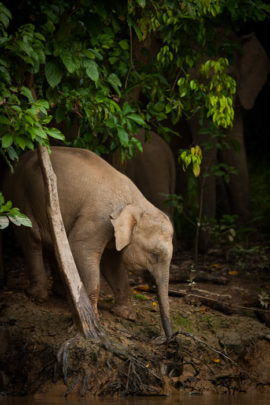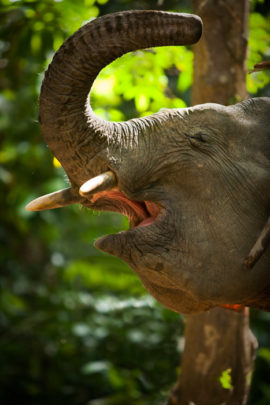Borneo’s “Pygmy” Elephants

Borneo’s “Pygmy” Elephants are a subspecies of the mainland Asian elephant. There are less than 2,000 of Borneo’s elephants, most of which can be found in the Malaysian State of Sabah. The word Pygmy would suggest that these elephants are much smaller than their mainland cousins but in reality, they are only slightly smaller. That is easy to say until you wander across one in the rainforest and then an elephant is an elephant and it is probably best to step out of their way.
The health of the forest is in many ways connected to healthy elephant populations. Their need for protected areas and migration corridors literally protects hundreds of species, including amphibians, insects, mammals, birds and many others. In turn, the health of the landscape supports human communities in their livelihoods.
The Houston Zoo has worked with the Danau Girang Field Centre in Sabah (Borneo), Malaysia since 2009 in support of a program to determine the social structure, migration corridors and habitat use of the Bornean Elephant. A hungry elephant does not know it is eating your crops, it simply knows it has found a new source of food. At the same time, those elephants need to find their way back and forth across the rivers and through the rainforest safely without encountering villages or fence lines.

Enter Nurzhafarina (“Farina”) Othman. Farina is a Malaysian researcher who is finishing her PhD with Cardiff University and looking at solutions to protect elephants and people from the above scenarios. Her work, which been supported by the Houston Zoo for many years and is our elephant conservationist and researcher in Borneo, assists the Sabah Wildlife Department in determining best practices for the conservation and management of the elephants in the region. Her teams work has also determined that the genetics data and historical records support the theory that the Bornean elephant might be a remnant of an extinct population from Java, making these populations unique.

Elephants require large amounts of land to live and when that land is turned into farms or plantations, the elephants sometimes move through the crops to get to more habitat. “Elephants are not moving through palm oil plantations to raid crops but they are using it to reconnect to their surrounding habitat because the corridors that have been left for them are too small,” says Farina. She also is working with palm oil plantations to find solutions for wildlife as well as helping with the Borneo tourism industry of which elephants are a large draw for the local economy.
